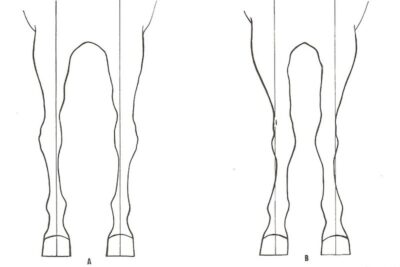The horse with a deviated pastern or cannon bone is a crooked legged horse. As part of the initial assessment, always assess if the horse is right or left handed in order to start on the biggest hoof. Next, always get the hoof in balance. It requires a correct equal balanced measurement between toe and heel and another balanced measurement between inside and outside (medial/lateral measurement). It is also necessary to achieve a T-square along the back of the pastern and the back of the heels.
In the straight legged horse, balancing the hoof will then allow the hoof to travel in a straight line from leaving the ground to where it next lands on the ground. However, on the crooked legged horse, it is interesting to note that it is still important to achieve the balanced hoof with the hoof landing square on the ground to the point where the hoof would actually travel in a straight line.
We did an experiment at one of my recent courses. After correctly balancing the hooves, I put a white dot at the centre front of the hoof above the toe clip area, and we then watched this crooked legged horse with balanced feet walk up and down the pathway towards us.
The interesting thing was that although the horse was crooked legged, the white dot that we placed on the centre of the hoof actually travelled in a straight line towards us, so that if you eyeballed the white dot, it was almost hypnotic, as the centre of the hoof travelled in a straight line, but because of the deviated cannon bone, in which the cannon bone is set either to the inside of the knee joint or the outside of the knee joint, the leg joint wobbled crazily all over the place while in flight, under the influence of the crooked leg bone structure. But the centre of the hoof stayed in a straight line.
A hoof will travel in the direction of its longest point. Flares that are the direct result of crooked leg bone structure will flare to the opposite point; that is, if the horses cannon bone is set to the inside of the knee joint, it will always flare to the outside of the hoof. If the cannon bone is set to the outside of the knee joint, it will flare on the inside, thus the horse will be pigeon toed in the latter or splay footed in the former.
In each case the heels must be kept level, the hoof must be kept level, there must be a T-square along the back of the pastern and the back of the heels; then once the leg is in flight, the bone structure and the muscle memory takes over the flight of the hoof through the air. There is nothing that can be done about this, as it is a conformation problem, it is a deformity; this is the way the horse is comfortable, and it will travel through the air according to the deviation in the bone structure. It is important also to note that we can correct lateral leg lameness in the horse by at least keeping the hoof level and flat on the ground so that even though it is a pigeon toed horse, it will still land pigeon toed and it will still take off pigeon toed, but the actual flight of the hoof is in a straight line.

It was a very interesting experiment to demonstrate so easily to the class, and a great way for any horse owner to check the flight pattern of the hoof.
